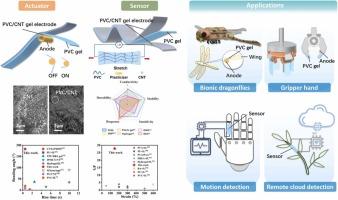Plasticized PVC/CNT flexible electrodes for highly responsive, stable, and durable soft actuators and wearable sensors
IF 3.7
1区 化学
Q1 CHEMISTRY, ANALYTICAL
引用次数: 0
Abstract
Plasticized polyvinyl chloride (PVC) gels have shown increasing potential for developing integrated actuation and sensing devices in soft robotics and wearable electronics. Notably, the flexible electrodes in PVC gel-based devices are crucial to their overall performance. However, traditional carbon grease electrodes substantially limit the functionality and stability of such devices, primarily due to their uneven distribution and inherent durability. To address these limitations, we propose a novel PVC/carbon nanotubes (CNTs) gel electrode (GE) for constructing dual-mode actuation-sensing devices with high performance and stability. We investigated the effects of three representative fillers-carbon black, graphene, and CNTs on the formation of molecular networks of the gel. Owing to its intrinsic one-dimensional geometry, CNTs facilitate the formation of a 3D percolating network, enabling PVC/CNTs GE (PCGE) to achieve an unprecedented charge carrier density of 3.31 × 10 ¹ ⁷ cm⁻³ . The PCGE demonstrates a high electrical conductivity of 79.9 mS/cm (4.2 times higher than carbon grease), an ultralow 30-day impedance growth rate of 8.4 % (a 70-fold reduction), and a minimal 10,000-cycle drift of 1.25 %(a 51-fold improvement), surpassing carbon grease in both conductivity and durability for flexible electronic applications. The PCGE-based bending actuators exhibited remarkable performance (182° at 3 V/μm) and a fast response (2 Hz). Moreover, the PCGE-based sensors achieved high sensitivity (GF>35), precise resolution (0.06 %), and ideal dynamic response (0.5–4 Hz), addressing the durability limitations of carbon grease. Additionally, the actuators achieve biomimetic applications in robotics, demonstrating their potential as artificial muscles. In contrast, the sensors enable motion tracking, showcasing broad applicability in intelligent sensing systems.

塑化PVC/碳纳米管柔性电极的高响应,稳定,耐用的软执行器和可穿戴传感器
增塑化聚氯乙烯(PVC)凝胶在开发软机器人和可穿戴电子产品的集成驱动和传感设备方面显示出越来越大的潜力。值得注意的是,PVC凝胶基装置中的柔性电极对其整体性能至关重要。然而,传统的碳脂电极极大地限制了这种设备的功能和稳定性,主要是由于它们的不均匀分布和固有的耐用性。为了解决这些限制,我们提出了一种新型的PVC/碳纳米管(CNTs)凝胶电极(GE),用于构建具有高性能和稳定性的双模驱动传感装置。我们研究了三种具有代表性的填料——炭黑、石墨烯和碳纳米管对凝胶分子网络形成的影响。由于其固有的一维几何结构,cnt有助于形成三维渗透网络,使PVC/ cnt GE (PCGE)达到前所未有的载流子密度3.31×10¹⁷cm⁻³。PCGE具有79.9 mS/cm的高导电性(比碳脂高4.2倍),超低的30天阻抗增长率为8.4%(降低了70倍),最小的10,000周期漂移为1.25%(提高了51倍),在柔性电子应用方面的导电性和耐用性都超过了碳脂。基于pcge的弯曲致动器在3v /μm下可弯曲182°,响应速度快(2hz)。此外,基于pcge的传感器具有高灵敏度(GF>35),精确分辨率(0.06%)和理想的动态响应(0.5-4 Hz),解决了碳脂的耐用性限制。此外,驱动器在机器人技术中实现了仿生应用,展示了它们作为人造肌肉的潜力。相比之下,传感器可以实现运动跟踪,在智能传感系统中具有广泛的适用性。
本文章由计算机程序翻译,如有差异,请以英文原文为准。
求助全文
约1分钟内获得全文
求助全文
来源期刊

Sensors and Actuators B: Chemical
工程技术-电化学
CiteScore
14.60
自引率
11.90%
发文量
1776
审稿时长
3.2 months
期刊介绍:
Sensors & Actuators, B: Chemical is an international journal focused on the research and development of chemical transducers. It covers chemical sensors and biosensors, chemical actuators, and analytical microsystems. The journal is interdisciplinary, aiming to publish original works showcasing substantial advancements beyond the current state of the art in these fields, with practical applicability to solving meaningful analytical problems. Review articles are accepted by invitation from an Editor of the journal.
 求助内容:
求助内容: 应助结果提醒方式:
应助结果提醒方式:


